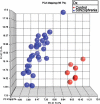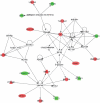An integrative functional genomics approach for discovering biomarkers in schizophrenia
- PMID: 22155586
- PMCID: PMC3277082
- DOI: 10.1093/bfgp/elr036
An integrative functional genomics approach for discovering biomarkers in schizophrenia
Abstract
Schizophrenia (SZ) is a complex disorder resulting from both genetic and environmental causes with a lifetime prevalence world-wide of 1%; however, there are no specific, sensitive and validated biomarkers for SZ. A general unifying hypothesis has been put forward that disease-associated single nucleotide polymorphisms (SNPs) from genome-wide association study (GWAS) are more likely to be associated with gene expression quantitative trait loci (eQTL). We will describe this hypothesis and review primary methodology with refinements for testing this paradigmatic approach in SZ. We will describe biomarker studies of SZ and testing enrichment of SNPs that are associated both with eQTLs and existing GWAS of SZ. SZ-associated SNPs that overlap with eQTLs can be placed into gene-gene expression, protein-protein and protein-DNA interaction networks. Further, those networks can be tested by reducing/silencing the gene expression levels of critical nodes. We present pilot data to support these methods of investigation such as the use of eQTLs to annotate GWASs of SZ, which could be applied to the field of biomarker discovery. Those networks that have association with SNP markers, especially cis-regulated expression, might lead to a more clear understanding of important candidate genes that predispose to disease and alter expression. This method has general application to many complex disorders.
Figures





References
Publication types
MeSH terms
Substances
Grants and funding
LinkOut - more resources
Full Text Sources
Other Literature Sources
Medical

